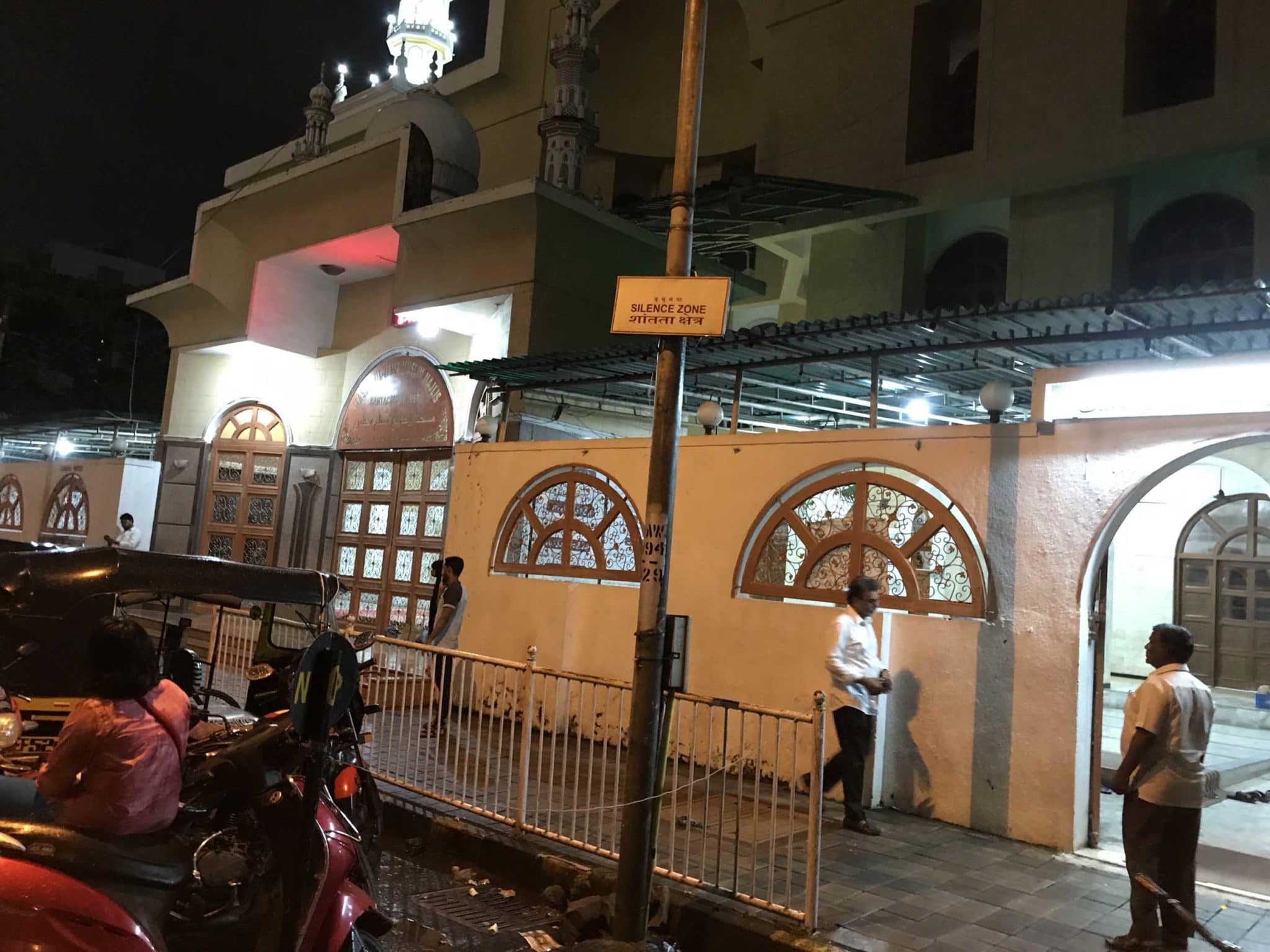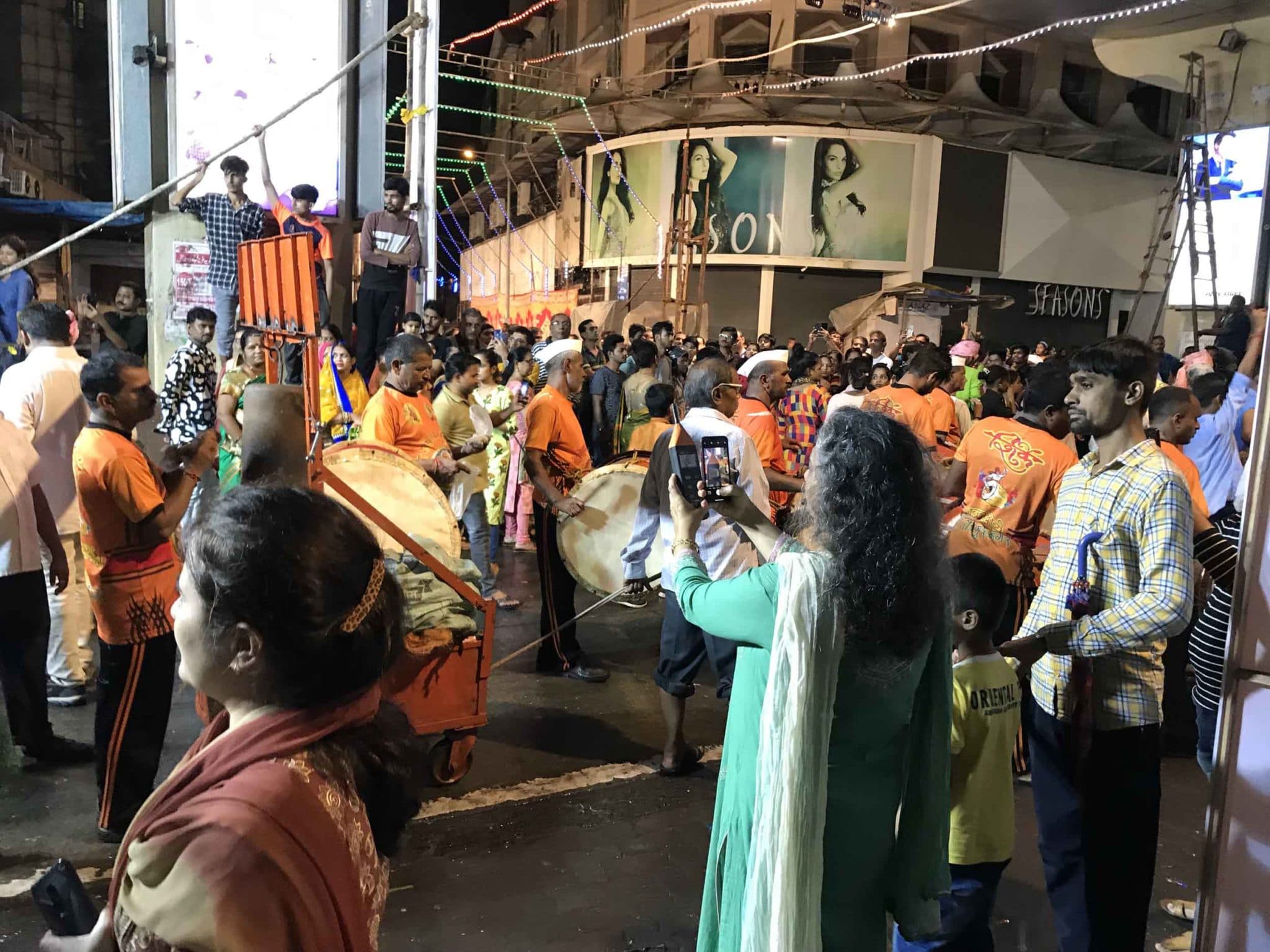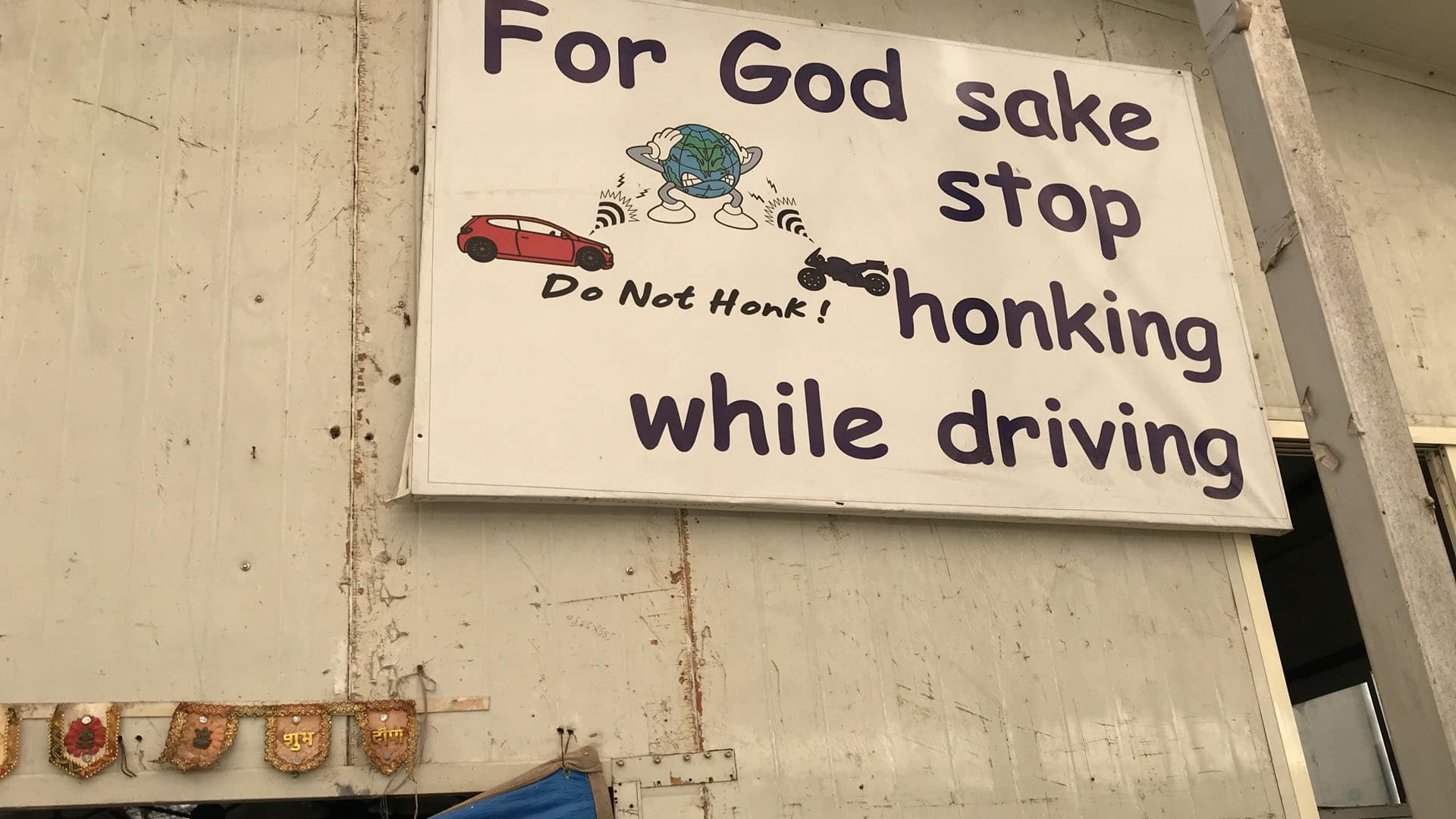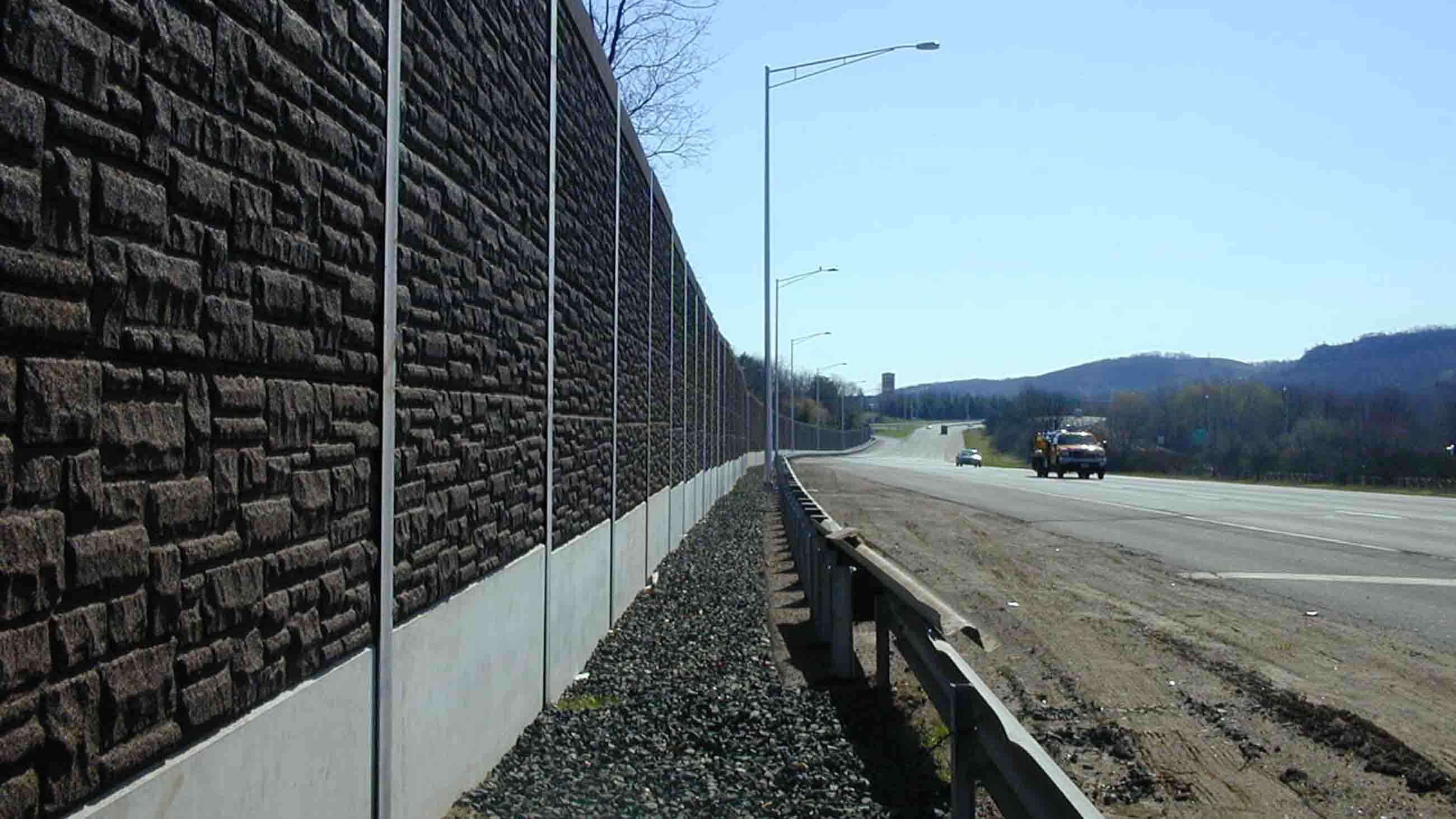The Fight to Curb a Health Scourge in India: Noise Pollution
On a muggy September evening during festivities for the Hindu god Ganesh, Sumaira Abdulali darted through Mumbai’s crowded streets with a handheld sound meter. After 10 days of prayers and offerings, this was the night of Ganpati, when thousands of Ganesh idols are paraded down to the sea for ceremonial immersion.
Abdulali, an environmental activist, hurried across a street swarming with auto rickshaws that honked and revved their engines. In the next block, a 10-foot elephant-headed Ganesh followed a platoon of dhol tasha drummers, clarinetists, and the tinny melody of a bulbul tarang, the Indian banjo, amplified by mounted loudspeakers. As they approached, the drummers drowned out every other sound — the crowd, the honking, and even the shrill whistles of the traffic police. Abdulali’s sound meter registered 115 decibels, as loud as a chainsaw and a danger to hearing in less than a minute.
This sound check, one of dozens that night, was part of Abdulali’s nearly two-decade war on noise pollution in Mumbai, a city that many researchers agree may be among the loudest examples of a global public health problem. In a rapidly growing and urbanizing world, more people are exposed to more noise, and multiple reports by the World Health Organization, most recently in 2018, indicate that rising decibel levels are among the top environmental risks to health. This is particularly true for the exploding, high-density megacities of the developing world, where the cacophony of urban growth is uniquely unrelenting. In addition to hearing, the reports suggest, noise harms the body more broadly, from sleep patterns to brain development to cardiovascular health.
“We’ve known about some of these health impacts for decades,” said Richard Neitzel, an environmental health scientist and noise researcher at the University of Michigan’s School of Public Health, who notes that some activists have labeled noise the next secondhand smoke.
“I think the key difference is tobacco smoke causes cancer and emphysema that kills you outright,” he said. “Noise effects are a little more indirect, but they can be just as lethal.”
Abdulali, who has earned the nickname the Minister of Noise, and a grassroots network of other concerned citizens have steadily made the case that the sonic onslaught is not just a nuisance but also a serious health hazard. They have taken offenders to court to force new regulations. And when those regulations were largely ignored, they have kept up the pressure for enforcement, taking their noise meters to the streets and publicizing their findings on social media. But fighting noise has often meant fighting powerful interests, for whom loudness represents political potency, economic dynamism, and growth. Festival organizers and their political allies, for instance, have pushed back, calling the anti-noise campaigns extreme, arbitrary, and even biased against Hindu celebrations.
At the Ganesh festival, Abdulali showed her sound reading to a nearby policeman. Rather than quiet the ear-popping performance, he promised to call in a special squad armed with their own sound meters. There was no time to verify this. The streets were crammed with countless other noisy processions that demanded Abdulali’s attention. Still, she counted the promise as progress.
Back in 2003, when she started patrolling Mumbai, no cops would have joined her on the front lines. In fact, she recalled, “everyone told me that nobody can control noise in Mumbai, or anywhere in India, because we are a noisy people. We like noise.”
But Abdulali knew better. Early on, she’d offered her cell phone number to be published as a noise-complaint hotline in the Times of India. “People were really, really disturbed. They would cry on the phone,” she said. “They would tell me, ‘we know you can’t help us, but at least you’re listening to us and not telling us that it’s us who are crazy for feeling so impacted.’”
At the festival, Abdulali moved on to a phalanx of drummers wearing orange shirts and white Gandhi caps. Behind them, a man hammered on an empty metal oxygen canister hanging from a rolling wooden frame. The procession leader spotted Abdulali and motioned for the hammer-wielder to ease up, but not before she clocked him at 120 decibels. (Decibels measure sound on a logarithmic scale, meaning that every 10 decibels represent a 10-fold increase; a 60-decibel conversation has 10 times the acoustic intensity of a 50-decibel refrigerator hum.)
The National Institute for Occupational Safety and Health (NIOSH) recommends no more than eight hours a day at a weighted average of 85 decibels, about as loud as heavy traffic. The recommended exposure limit is halved for every three-decibel increase in volume, and it’s cumulative. So, even if someone works in a very quiet place, such as library, they will hit that danger threshold if they listen to 88-decibel music during their half-hour commute and later spend an hour and a half with friends at a local bar that hits 91 decibels.
When sound reaches 120 decibels — like the oxygen-tank-clangs — it can cause almost instant hearing damage by destroying tiny hair cells in the inner ear, according to the Centers for Disease Control and Prevention. These hairs cells transform the vibrations of sound into electrical signals that travel to the to the brain, which interprets and sorts them into the sounds we hear. Over time, loud noise can kill enough of these critical cells to degrade hearing and cause the ringing in the ears known as tinnitus.
Audio: Chris Berdik
Noise is also linked to chronic stress and sleep disruption, both of which are bad for heart health. One study published in the BMJ in 2013, for instance, examined the health records of some 6 million Americans 65 and older living near airports, and found that every 10 decibel rise in aircraft noise exposure correlated with a 3.5 percent rise in hospitalizations for heart trouble. Similarly, a 2014 analysis published in the journal Noise and Health examined 14 previous noise studies undertaken mostly in the United Kingdom and continental Europe, as well as Canada and Japan. That analysis found that across the various study locales, average heart-disease risk bumped up 8 percent for every 10-decibel uptick in highway noise. Between hearing loss and stress-induced health problems, the WHO estimated that noise pollution annually robs Western Europe’s 340 million people of at least 1 million disability-free years.
“It has been well documented that noise exposure contributes to hearing loss, tinnitus, heart disease, stroke, anxiety, stress, depression, learning difficulties, job performance, sleep disorders, and reduced cognitive abilities,” declared the American Academy of Nursing in a 2016 position statement. “Noise is more than an annoyance; it is a public health hazard.”
While most research on noise and health comes from Europe and North America, studies out of India and other developing countries are showing elevated rates of hearing loss in high-noise occupations. For instance, in 2015, the Indian Journal of Community Health published a study of 150 traffic police in the northern city of Jammu. Officers who had been on the job for at least three years showed about six times as much hearing loss as officers who had spent less time on the streets. Another study conducted in Vadodara, the third largest city in the northwest Indian state of Gujarat, found hearing loss in 80 out of the 88 traffic police tested. And a small 2018 study published by researchers in Chennai, the capital of the Indian state of Tamil Nadu, checked the hearing of 30 auto-rickshaw drivers and diagnosed 23 with hearing loss.
India’s physicians are increasingly trying to spread the word that that noise hurts health, said Sujata Rao, an ear, nose, and throat doctor and past president of the Association of Medical Consultants in Mumbai, a medical advocacy and education group. That message can be a tough sell during festival season. “In India, celebrations are equated with noise, and that association can’t be banished or washed off so easily,” said Rao. “But, slowly and surely, I think if the health effects of noise become more known, probably a change in mindset may occur.”
To bolster awareness, doctors from the Indian state of Kerala created the National Initiative for Safe Sound (NISS) in 2013. “We were all noticing an increase in hearing loss,” said NISS co-founder, C. John Panicker, an ear, nose, and throat doctor and vice president of the Indian Medical Association. The initiative has since spread nationwide, hosting annual conferences, publishing booklets, and offering legal advice for people fighting noise pollution.
Abdulali has worked with NISS to spread no-honking days throughout India. “I think everyone is concerned with their own health. It’s just that they haven’t quite made the link with noise,” she said. “And they haven’t made that link, because they’ve been misinformed. They’ve been told by the politicians who make this noise that it’s just for a little while, just a few days of the year. And you’re having fun. They’re not told that it accumulates.”
A few miles from the main beach where the Ganesh idols would end up in the sea, the raucous parades passed a mosque with a white sign the size of a license plate reading: Silence Zone. The ongoing struggle over these silence zones — areas within 328 feet of schools, hospitals, courts, and places of worship where sound must be limited — tracks the history of noise-pollution activism in Mumbai.
The city’s first anti-noise campaign began in the mid-1980s, with a group of Mumbai residents led by Yeshwant Oke, a pediatrican, and Saad Ali, a local businessman and Abdulali’s late uncle. Using local sound readings and a report from the WHO, the activists filed a series of public interest litigation cases against factories in residential areas, houses of worship blasting prayers from roof-mounted loudspeakers, and all-night discos during festival season.
In the early 2000s, Abdulali, who was then a young mother looking for part-time work, volunteered to help. In 2000, a string of legal victories culminated with a court ordering the environmental ministry to create nationwide noise-pollution laws. The rules set day and night decibel limits by zone — including the silence zones. The use of loudspeakers was prohibited after 10 p.m. (In October 2002, the Indian government amended the rules to let local governments extend the cutoff to midnight on 15 days each year.)

But the new rules didn’t address enforcement. How would people know where the silence zones began and ended? What agency would devote the resources to measure the noise? And who would go to court to punish violations that could, technically, lead to stiff fines or up to three months in jail?
With no clear answers, the laws were mostly dead letters until Abdulali and allies began pushing the rules city-by-city. Armed with sound data, the activists returned to court to file petitions of non-compliance and contempt citations against authorities who failed to stop the racket. For instance, in 2009, Abdulali won a court order that the Mumbai city government needed to mark the silence zones with signs. She is now pushing for the zones’ boundaries to be put on an official city map to help shape urban planning, development, and licensing.
Besides fighting noise in the courts, Abdulali has spent years trying to convince her fellow Mumbaikars that she is not anti-religion, anti-development, or anti-fun, but rather concerned about their wellbeing. Collaborating with charities, universities, and NGOs, she has provided free hearing screenings to traffic police and others, created anti-honking social media campaigns, and developed education initiatives such as a student-created public service announcement against firecrackers during festivals.
Some officials have warmed to the activists’ efforts. Mumbai police spokesperson, Pranaya Ashok, said that every police station in the city has five to 10 noise meters, which they’ve used to confirm around 500 cases — out of 7,198 incidents — where noise levels have broken the law. A lot of the time, the noise stops before the police can arrive on the scene. Ashok also noted that quieting a metropolis like Mumbai is daunting. “Being a city which is constantly on the move and adding the volumes of traffic, the continuous construction activity, and the industrial units,” he said, “the ambient noise levels are already very high,” quite often over the legal limits. Still, Ashok insisted, “if a complaint comes to us, we definitely take action.”
There is no denying that Mumbai is loud. A 2018 study by the Indian government’s National Environmental Engineering Research Institute (NEERI) analyzed noise readings from Mumbai and about two-dozen other cities in the state of Maharashtra. Mumbai’s average noise levels were well over the legal limits (for instance, 80 decibels, as loud as a vacuum cleaner, at night in residential areas). The city’s loudest spot, according to a sound meter mounted around the height of an adult by NEERI, was at the intersection outside the central train terminus. The intersection averaged 95 decibels — or power-tool territory. And it isn’t unusual for people to be hit with decibels in the 70s and 80s range throughout a typical day in the city.
As in many global megacities, Mumbai’s noise is partly a side effect of explosive growth. Some 23 million people are estimated to live in the metropolitan area, up 5 million since the most recent census in 2011. The city’s infrastructure can’t keep up. The roads are overwhelmed with vehicles and pedestrians avoiding the sidewalk scrums. According to the lead author of NEERI’s 2018 noise study, environmental engineer Ritesh Vijay, the resulting stream of blaring horns is the worst noise offender.
“Whether it’s a highway, or a city street, or an expressway, people honk like anything,” Vijay said by cellphone from Nagpur, another Maharashtra city featured in the report. In the background, a chorus of horns blared. “My God,” he yelled. “I should say, I’m sorry about all the honking.”
Indian drivers consider honking to be “a means of self-expression,” said Abdulali, whether it’s happiness, boredom, or anger. “We’ve forgotten that the horn was originally a safety device,” she added. “And only a safety device.”
In addition to honking, Abdulali blames the omnipresent construction that often continues through the night, as well as a noise source that’s especially prevalent in Mumbai — the street festivals. Festival season starts after the summer monsoons and continues well into the spring with a series of Hindu, Muslim, Sikh, Christian, and secular holidays, many observed over multiple days, and celebrated with parades, outdoor music, and firecrackers.
Lowering the volume of these festivals is complicated, because many are intertwined with politics. The Ganesh celebrations, for example, dating to the late 19th century when a leader of India’s freedom struggle named Lokmanya Tilak transformed a fairly private observance into a major social gathering and carnival. Not only did the public observances promote Hindu solidarity, they also gave cover to meetings and fundraising to help undermine British colonial rule.
Political parties and their neighborhood representatives have since taken charge of Ganesh festivities. The streets are lined with temporary pavilions — called pandals — that hold painted plaster idols, and right next to those are collection boxes for offerings by locals who pray for the god’s blessings. In fact, months before the festival, fundraisers go door to door collecting cash that supports an expansive festival economy — the local contractors who build and decorate the pandals, artists who create the idols, the musicians who march in the processions, and all the merchants needed to sustain 10 days of celebration.
The politicians and festival organizers sometimes clash with noise pollution activists. Abdulali said she’s been shouted and cursed at when her sound metering shuts down a deafening musical performance or political rally. The thousands of politically-connected groups that organize the Ganesh celebrations, known as mandals, have made repeated appeals to state authorities that the silence zones should either be abolished or lawfully ignored on special nights such as Ganpati.
“This is India, and our festivals are celebrated with a bang,” said one mandal leader in a 2017 interview for the Indian news website, Scroll.in. “How can we take out our processions if there are silence zones everywhere?”
Reached by phone, Naresh Dahibawkar, the president of an organization representing some 10,000 mandals in Mumbai said his group has actually enforced quieter processions among its members in recent years. Still, he wants the restrictions on noise lifted for a few nights of the Ganesh festival, including Ganpati, to give Mumbai’s young dancers, actors, and musicians ample time on stage to show off their talents to the huge crowds.
“It’s not because I want to violate the noise pollution rules,” he said. “But let us organize these entertainment programs. Our only intention is to provide a stage to children, to help them become artists.”
Dahibawkar also echoed the criticism many have levied against Abdulali, which is that she is unfairly targets Ganpati and other Hindu festivals for her anti-noise campaigns. “I told her, that you people wake up only when Ganpati festival comes around,” he said. “Where are they during other festivals?”
But in addition to metering non-religious noise violations such as car horns and the late-night construction of new Mumbai metro lines, Abdulali said she regularly tracks decibels during the Muslim festivals of Eid. And in December 2018, an angry crowd surrounded and threatened her at the Mahim Fair honoring the Sufi Muslim scholar and saint Makhdum Ali Mahimi. Police had to escort her to safety.
For Abdulali, progress has come in fits and starts. On April 7, 2008, she had a success: The Mumbai traffic police joined her to mark the city’s — and the country’s — first no-honking day and stepped up related fines. In January 2018, the effort expanded into a Horn Vrat — literally a horn fast — supported by the Maharashtra transportation department and the auto rickshaw drivers’ union. For months, volunteers drove an auto rickshaw adorned with 150 bicycle horns and handed out flyers on the dangers of noise, which encouraged drivers to curb their honking (Ashok, the police spokesperson, said there are no firm data showing honking has improved in general). And as for the silence zones, more than 1,500 were recognized across Mumbai by 2017.
But in August of that year, the Indian government amended the noise rules so that silence zones had to be designated by state governments, rather than local authorities. That change invalidated every silence zone in Mumbai (110 of them have since been reinstated). The setback had a silver lining, according to Abdulali, who credits the resulting uproar and public pressure for the government’s 2018 decision to ban DJs blasting Bollywood music in festival processions. And the ban led to quieter 2018 and 2019 festival seasons, according to her noise data, which has been used by the Bombay High Court and, she said, verified by the police and the Pollution Control Boards.
The DJs went to court to fight the ban, represented by the Professional Audio and Lighting Association (PALA India). A final ruling is still pending. In a phone interview, the lawyer representing the DJs, Satish D. Talekar, called the ban “very arbitrary,” noting that traditional instruments are incredibly loud but left alone. The sound and lighting professionals rely on festivals to earn a living, he said, and now “their business has come to a standstill.”
“Apart from that, there are many issues involved in it,” he continued, from personal liberty to “even the fundamental right of practicing religion.”

Back at the Ganesh festival, shortly before 10 p.m., a truck blared music from roof-mounted loudspeakers at 115 decibels near Mumbai’s Shivaji Park. Abdulali alerted a police officer who told the driver to turn the music down. Still gripping her sound meter, Abdulali continued down the road. A man on a blue Yamaha motorcycle slowed beside her, his engine rumbling as he matched her pace. He looked over a couple times before leaning in, saying something, and speeding off.
“He just said, thank you for your service,” Abdulali translated.
Standing in an old colonial section of the city watching about half a dozen Ganesh idols lumber toward the sea, Abdulali said that this Ganpati was more subdued than usual. While the decibel levels of individual processions were still dangerous, the extreme loudness was less omnipresent than in year’s past. “Normally, this whole street would be filled with noise from DJs,” she said, not just from the idols but from speakers mounted on the balconies and verandas, creating a flood of sound that would echo off the hulking stone buildings.
Noise improvements have also spread beyond Mumbai. A few hours away in Pune, a biology professor at the College of Engineering named Mahesh Shindikar and a platoon of students have fanned out across the city to take 24-hours of sound readings during Ganpati for the past 18 years. For the first few years, the 24-hour average hovered around 90 decibels before climbing to 114 decibels in 2013. It has fallen since then, and in 2019 it dipped down to 86 decibels. In Delhi, an activist named Ravi Kalra has led no-honking days and noise awareness campaigns for more than a decade. And in other cities, people have followed Abdulali’s lead and gone to court to get local enforcement of noise laws.
For example, Mahesh Bedekar, an obstetrician and gynecologist who runs a hospital for mothers and newborns in the Mumbai suburb of Thane, found that noise from two nearby marriage halls was disrupting his patients’ sleep. When he complained, the local police took no action. So he filed public interest litigation to force silence-zone recognition for hospitals throughout Thane.
During the Ganesh festival in Ulhasnagar, an hour east of Mumbai, drummers perform directly beneath a city billboard against noise pollution. Ulhasnagar is the noisiest urban area in the Indian state of Maharashtra, according to the Indian government’s National Environmental Engineering Research Institute (NEERI).
Visual: Chris Berdik
Further east in the city of Ulhasnagar, the noise-pollution enforcer is Sarita Khanchandani, a former science teacher. During her 18 years in the classroom, part of her curriculum was environmental conservation, but the disconnect between these lessons and India’s worsening pollution bothered her.
“I started asking myself, what am I doing? I’m just imparting theoretical knowledge. There’s nothing practical about it,’” Khanchandani said. In 2011, she founded an environmental activism group called the Hirali Foundation, focusing on noise because she assumed it would be an easier fix than air or water pollution. “I thought it would be easier,” she recalled with a laugh.
Ulhasnagar is the noisiest city in the state of Maharashtra according to the NEERI study, with weekday sound levels averaging 91.4 decibels. During festival season, Khanchandani races to the scene of noise complaints. She also tweets out every violation she finds and copies the local police.
Having local noise watchdogs is critical, said Abdulali. It’s relatively easy to put up a silence-zone sign or distribute no-honking pamphlets, but real enforcement takes commitment. “The rhetoric is great. But, it’s only where people are actually on the ground, speaking up, taking action, and forcing it to happen that it’s working,” she said. “Like Sarita in Ulhasnagar, if she wasn’t out there, then all the court orders in the world would not have done anything.”
As the night of Ganpati moved along, Abdulali followed the processions to the beach, noting every reading from her meter in a ledger and broadcasting some on Twitter. Ganpati is one of the nights each year where Mumbai authorities allow loudspeakers until midnight. As the clock ticked past 12, the idols continued their march, but the music faded. Not everywhere. Fifteen minutes after the deadline, Abdulali sound checked a procession where the drummers were still going strong. She showed the reading to a group of police, who approached the procession. The drummers delivered a percussive burst before going silent.
There was one final stop — the grandstands near the point on the beach where the Ganesh idols would float in the sea. Here, politicians routinely flout the noise laws, shouting words of welcome and celebration through loudspeakers well past midnight. She measured one group pushing 100 decibels and told a nearby cop.
“What can I do about it?” he shrugged. “Go and tell the senior officer.” The Mumbai police had a temporary headquarters on the beach, its interior hidden behind a wall lit by floodlights and plastered with a billboard collage of police photos captioned: “Your Safety. Our Responsibility.” Several cops milled around a doorway draped with garlands of marigolds.
Abdulali spoke briefly with one of the cops and then headed inside. About five minutes later, she emerged with several policemen, including the chief, with his three-star epaulets. His holstered 9mm pistol was another mark of high rank in a police force where most are not authorized to carry firearms. The others brandished long night sticks, and as the group marched back to the procession route, one of the officers broke off to swat the balloons of an unlicensed vendor, popping the lot.
The police headquarters had radioed ahead to the officers by the grandstands to pull the plug on the politicians. Soon the loudspeakers were silent. Satisfied that his orders had been obeyed, the chief took his leave. But another high-ranking officer soon appeared. He wore two-star epaulets, and instead of a pistol, he was armed with a noise meter.
He approached Abdulali and spoke with an aggrieved air, repeatedly holding up his sound meter for her acknowledgment. The officer wanted to show how her how diligent his team had been in their noise duties. (In previous years, she has filed or threatened contempt citations against police.)
Abdulali listened politely, but stone-faced, with tired eyes and sweat beading up on her forehead. A few more cops joined the presentation, including a couple others with sound meters, one of which they connected to a handheld printer that spat out the noise readings taken that night.
After the group broke up, Abdulali said she still isn’t sure how to measure progress. “The truth is, I don’t know,” she said. “But the fact that these police are carrying noise meters at all — no matter what they actually do with them — and the fact that people see me and my noise meter and know what it’s about, I mean, I never thought this day would come.” Then, she laughed. “Now, if only we could do the same for honking.”
Chris Berdik is a freelance science and education journalist in Milton, Massachusetts. He is writing a book about noise pollution for Norton.
Puja Changoiwala contributed reporting to this piece.











 This story was supported by the
This story was supported by the 
Comments are automatically closed one year after article publication. Archived comments are below.
I live in a gated community in India. Next to our society, there’s a mosque. Every morning at 5 o’clock loudspeakers roar with morning prayers. I often wonder, why can’t they pray silently?
I’m glad to see an article on noise pollution. So much could be done here in the US, but President Reagan zeroed out the noise pollution office in EPA very early in his admin.
Years ago, probably in the early ’80s, I saw a jackhammer, in Alexandria VA, that wasn’t making a sound while in use. I’ve never seen one again, nor heard anything about them.
Backup beepers, lawn services, and especially leaf blowers are major offenders. Backup beepers aren’t even very effective, and at this point in time, they could be inexpensively replaced with back-up cameras, which would be much more effective. Here’s an article I wrote some years on backup beepers. http://www.ncbi.nlm.nih.gov/pmc/articles/PMC3018517/
Mumbai is an impossible city. You write about many aspects on noise pollution, but forgot to mention the recent initiative taken by traffic police to reduce the honing. In this approach the time for the red light increases with honking. I do not now the extent of success, but sure this is one more way to discourage honking. Also the noise pollution due to fire cracker seems to have reduced. Thanks to all who are actively seeing solution for this age old and annoying problem.